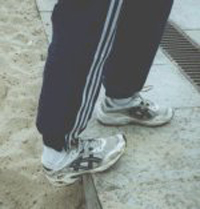Shin splints – Physiotherapy treatment and self management
What is it?
Shin splints (or posterior shin splints) refers to a symptom of pain over the front and inside of the shin bone. This pain can come from the muscles (tibialis posterior) or the muscle attachment onto the bone, or a irritation of bone itself or a combination.

What causes it?
Shin splints can be caused by a number of conditions:
- Medial or Lateral tibial stress syndrome – over use of the muscle where it attaches onto the bone, which can progress to cause irritation of the bone itself and can lead to stress fractures.
- Stress fractures – the tibia (or shin) starts to fracture with repetitive stresses
- Medial tibial compartment syndrome – excessive muscle swelling, causing loss of circulation to the muscle which causes pain, weakness and even altered sensation (such as pins and needles and numbness).
All of these conditions are usually brought on by over training, or running on a very hard surface or poor biomechanics (e.g. flat feet) or poor footwear.
How can it be treated?
It is important to treat the underlying cause of shin splints, often this means addressing a number of factors depending on the individual including:
- Ensuring the correct foot wear is being worn for the individuals foot-type
- Reducing muscle tightness (calf tightness is common in shin splints)
- Reduce any inflammation around the bone (with medication and ice)
- Correct any biomechanical abnormalities which are contributing (such as foot pronation – flat feet, knee rotation when running, poor glut control) eg with use of orthotics
- Correct the training regimen – if the person is over training or doing too much training on a hard surface (such as the road/ foot path)
- Correct any strength deficits (often the calf and tibialis posterior are found to be weak)
- Soft tissue massage for tight muscles (often the calf muscle)
What happens if you ignore shin splints?
If you continue to push through the pain with running, the tendons of the muscle can start to put so much strain on the bony attachments that it starts to cause stress fractures in the shin. This can take a long time to recover from.
What can you do to self manage shin splints?
- Don’t push through the pain – you need to reduce your exercise program (eg change to swimming or cycling to maintain cardiovascular fitness)
- Apply ice wrapped in a wet cloth over the painful area for 15 minutes daily
- Stretch – the calf muscles (with the heel hanging over the edge of a step and push down for 30 seconds)
- If the tenderness to touch and pain with running does not settle within a week it is important to see your physiotherapist as there are probably other issues that need to be identified and addressed.
Gold Coast Physiotherapy and Allied Health at Burleigh Heads and Broadbeach 07 5535 5218








